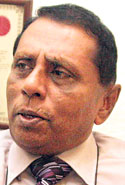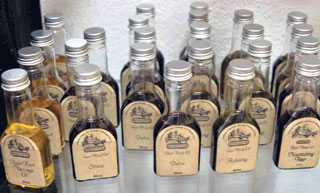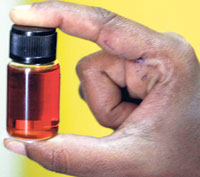With no injections or antibiotics in sight, ayurvedic massages make for a particularly pleasant dose of medicine. Used in the treatment of a wide range of diseases and especially in the management of chronic pain, the massage has many other benefits. The privately- run Siddhalepa Ayurveda Hospital routinely prescribes massages for patients.
Dr. Tudor Senadheera, the medical superintendent at the hospital, places a great deal of faith in this form of treatment. “The aim of the massage is to purify the blood,” he says, explaining that “there are toxin deposits in the tissues of the body.”
 |
| Dr. Senadheera |
He clarifies that massage is traditionally not included among the five Pancha Karma used for detoxifying blood: therapeutic vomiting (vamana), purgation (virechana), two kinds of therape utic enema (basti) and nose drops (nasya). Still, massage is gentler and involves less discomfort. Here, toxins are brought to the surface and expelled over the course of the hour long treatment that culminates in a steam bath. Depending on your body type and symptoms, a herbal bath or the application of warm herb-filled pouches might also be prescribed.
While the massage technique itself is carefully tuned to your condition, the real healing power lies in the oils that are used. Siddhalepa primarily employs gingelly or sesame oil as the base says Dr. Senadheera. Other ayurvedic treatments recommend sunflower oil. ‘Scientific Basis for Ayurvedic Therapies’ a book released in 2003, documented studies that held that both these oils contain substantial amount of linoleate in triglyceride form. Oils rich in linoleic acid are believed to have antineoplastic properties, in that they inhibit the growth or development of malignant cells.
With either sunflower or sesame oil as the base, various ingredients are added to the oils. An oil might have as many as 100 ingredients says Dr. Senadheera, explaining that while Siddhalepa uses approximately 60 varieties, there can be as many as 1000 different combinations in ayurveda itself. Which oil gets applied is decided by your doctor just prior to the massage.
The consultation begins with the physician taking your pulse. A medical history is taken and is followed by a thorough physical examination. From lung function to bowel movement, from diet to sleeping habits, from the mobility of your joints to the condition of your skin, this examination helps the doctor identify your body type.
As a holistic system that places as much emphasis on prevention as on cure, Ayurveda aims to balance the three central energies, or doshas: vata, pitta and kapha. Vatta is like air and imbalances can cause pain, migraine and paralysis. Pitta is akin to fire, and imbalances can cause digestive, hormonal and skin disorders. Kapha is like water, and imbalances can cause high cholesterol, respiratory problems and colds.
Everybody encompasses all three, but you may be predominantly one or the other depending on the balance of the different doshas, which are said to vary according to weather, state of mind and diet. Condensed from the five elements; the doshas are responsible for the physical and emotional state of the mind and body.
Together with the seven dhatus (tissues) and three malas (waste products) they make up the human body. Imbalance among the doshas is said to be the cause of disease.
The doctor identifies the cause of the imbalance and the consultation concludes with a prescription for the oils and a discussion with your masseur. Different oils are prescribed for the head and for the rest of the body and the masseur is made aware of the condition being treated, says Dr. Senadheera. The oil is applied as the masseur follows special pressure points across the body.
Ayurvedic massage therapy has been hailed as a cure for many diseases, including arthritis, rheumatism, neurasthenia, high or low blood pressure, sciatica, paralysis, polio and insomnia.
In some cases a single massage is all that is required, while in others your doctor might admit you to the hospital for an entire regimen, says Dr. Senadheera, adding that many people have reported almost immediate relief. Massages are particularly good for stress relief, he explains, adding that patients often come out relaxed and feeling limber.
The end of the massage is particularly crucial. The combination of medicated oils and careful kneading bring the toxins to the surface, but it is by inducing sweating that they are removed from the body. Sweating is believed to open up the channels and dilute the doshas which cause an imbalance in the patient’s system.
In the end, the massages have much to commend them. Some other advantages are outlined in the Charaka Samhita, counted among ayurvedic medicine’s best known texts. Vol.1, V:88-89 reads:
“The body of one who uses oil massage regularly does not become affected much even if subjected to accidental injuries, or strenuous work. By using oil massage daily, a person is endowed with pleasant touch, trimmed body parts and becomes strong, charming and least affected by old age.”
|




